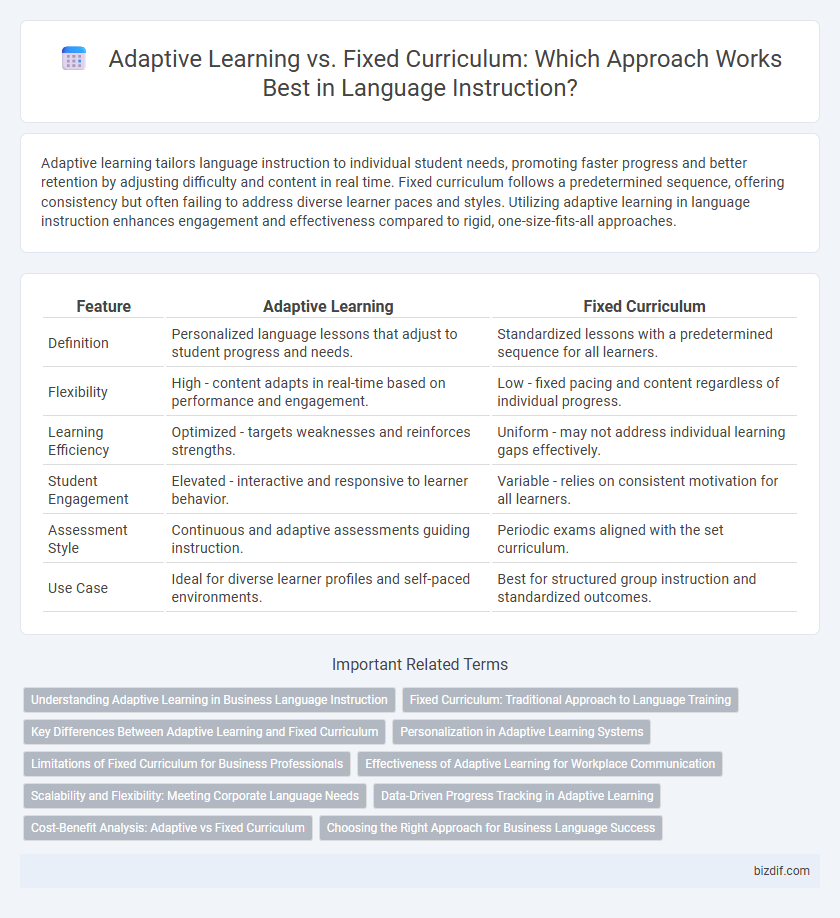Adaptive learning tailors language instruction to individual student needs, promoting faster progress and better retention by adjusting difficulty and content in real time. Fixed curriculum follows a predetermined sequence, offering consistency but often failing to address diverse learner paces and styles. Utilizing adaptive learning in language instruction enhances engagement and effectiveness compared to rigid, one-size-fits-all approaches.
Table of Comparison
| Feature | Adaptive Learning | Fixed Curriculum |
|---|---|---|
| Definition | Personalized language lessons that adjust to student progress and needs. | Standardized lessons with a predetermined sequence for all learners. |
| Flexibility | High - content adapts in real-time based on performance and engagement. | Low - fixed pacing and content regardless of individual progress. |
| Learning Efficiency | Optimized - targets weaknesses and reinforces strengths. | Uniform - may not address individual learning gaps effectively. |
| Student Engagement | Elevated - interactive and responsive to learner behavior. | Variable - relies on consistent motivation for all learners. |
| Assessment Style | Continuous and adaptive assessments guiding instruction. | Periodic exams aligned with the set curriculum. |
| Use Case | Ideal for diverse learner profiles and self-paced environments. | Best for structured group instruction and standardized outcomes. |
Understanding Adaptive Learning in Business Language Instruction
Adaptive learning in business language instruction tailors content and pacing to individual employee needs, enhancing skill acquisition efficiency and retention. Unlike fixed curricula, adaptive systems utilize real-time data analytics to identify knowledge gaps and adjust lessons dynamically, leading to personalized learning pathways. This approach improves learner engagement, accelerates proficiency, and aligns training outcomes with specific business objectives.
Fixed Curriculum: Traditional Approach to Language Training
Fixed curriculum in language instruction follows a traditional approach with predetermined lesson plans and pacing, ensuring a uniform learning experience for all students. This method relies on structured content delivery, focusing on grammar rules, vocabulary building, and standardized assessments that track progress uniformly across the cohort. While it offers consistency and ease of implementation, fixed curriculum often lacks the flexibility to address individual learner differences or adapt to varying proficiency levels.
Key Differences Between Adaptive Learning and Fixed Curriculum
Adaptive learning tailors educational content and pacing to individual student performance using real-time data analysis, unlike a fixed curriculum that follows a predetermined, uniform sequence for all learners. It employs algorithms to continuously assess learner progress and adjust difficulty, ensuring personalized engagement and mastery of concepts. Fixed curricula emphasize standardized content delivery and assessment, prioritizing consistency and uniformity over personalization.
Personalization in Adaptive Learning Systems
Adaptive learning systems leverage real-time data analytics and artificial intelligence to tailor educational content, pacing, and difficulty to individual learner needs, enhancing engagement and retention. Unlike fixed curricula, which follow a predetermined sequence regardless of student performance or preferences, adaptive learning personalizes instruction by continuously assessing skill gaps and adjusting lessons dynamically. This personalization fosters a more efficient and effective learning experience, improving outcomes across diverse student populations.
Limitations of Fixed Curriculum for Business Professionals
Fixed curriculums for business professionals often lack flexibility to address individual learning needs, resulting in slower skill acquisition and lower engagement. Such rigid structures fail to adapt to the fast-paced changes in industry-specific language requirements, limiting relevance and practical application. Consequently, learners may struggle with gaps in essential competencies, hindering professional communication and growth.
Effectiveness of Adaptive Learning for Workplace Communication
Adaptive learning enhances workplace communication by customizing training content to individual employee needs, resulting in higher engagement and retention rates. Studies show that adaptive platforms improve practical language application in real-time scenarios compared to fixed curricula with uniform pacing. This personalized approach accelerates skill acquisition and boosts overall communication effectiveness in professional environments.
Scalability and Flexibility: Meeting Corporate Language Needs
Adaptive learning systems offer superior scalability by tailoring language instruction to diverse employee skill levels, enabling personalized progression without overburdening training resources. Fixed curricula often lack the flexibility needed to address varying corporate language goals, leading to inefficient use of time and reduced learner engagement. Deploying adaptive learning solutions enhances organizational agility in meeting evolving language demands across global teams.
Data-Driven Progress Tracking in Adaptive Learning
Adaptive learning leverages data-driven progress tracking to personalize language instruction, continuously analyzing student performance metrics to adjust content and difficulty in real time. This dynamic approach contrasts with fixed curricula, which follow a predetermined sequence without accommodating individual learner needs or pacing. By utilizing detailed analytics, adaptive learning platforms enhance language acquisition efficiency and foster targeted skill development based on learner-specific data patterns.
Cost-Benefit Analysis: Adaptive vs Fixed Curriculum
Adaptive learning systems optimize educational outcomes by tailoring content to individual students' needs, resulting in higher engagement and improved retention rates compared to fixed curriculum models. While initial implementation costs for adaptive platforms are typically higher due to technology investments and content customization, these expenses are often offset by long-term benefits such as reduced dropout rates and accelerated learning timelines. In contrast, fixed curricula involve lower upfront costs but may incur greater indirect expenses linked to remediation and less efficient knowledge acquisition.
Choosing the Right Approach for Business Language Success
Adaptive learning tailors language instruction to individual employee needs, improving engagement and retention by adjusting content complexity based on real-time performance data. Fixed curriculum offers a standardized, consistent framework suitable for businesses with uniform language proficiency requirements or regulatory compliance demands. Selecting the right approach depends on workforce diversity, learning goals, and available resources to maximize business language success.
Adaptive Learning vs Fixed Curriculum Infographic

 bizdif.com
bizdif.com